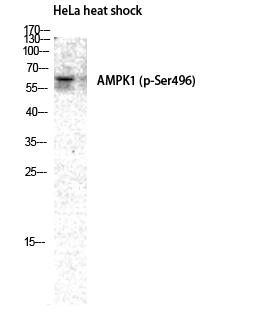AMPKα1 (phospho Ser496) Polyclonal Antibody
- Catalog No.:YP0010
- Applications:WB;IHC;IF;ELISA
- Reactivity:Human;Mouse;Rat;Canine;Fish
- Target:
- AMPKα1
- Fields:
- >>FoxO signaling pathway;>>Autophagy - animal;>>mTOR signaling pathway;>>PI3K-Akt signaling pathway;>>AMPK signaling pathway;>>Longevity regulating pathway;>>Longevity regulating pathway - multiple species;>>Apelin signaling pathway;>>Tight junction;>>Circadian rhythm;>>Thermogenesis;>>Insulin signaling pathway;>>Adipocytokine signaling pathway;>>Oxytocin signaling pathway;>>Glucagon signaling pathway;>>Insulin resistance;>>Non-alcoholic fatty liver disease;>>Alcoholic liver disease;>>Hypertrophic cardiomyopathy;>>Fluid shear stress and atherosclerosis
- Gene Name:
- PRKAA1
- Protein Name:
- 5'-AMP-activated protein kinase catalytic subunit alpha-1
- Human Gene Id:
- 5562
- Human Swiss Prot No:
- Q13131
- Mouse Gene Id:
- 105787
- Mouse Swiss Prot No:
- Q5EG47
- Rat Gene Id:
- 65248
- Rat Swiss Prot No:
- P54645
- Immunogen:
- The antiserum was produced against synthesized peptide derived from human AMPK1 around the phosphorylation site of Ser496. AA range:451-500
- Specificity:
- Phospho-AMPKα1 (S496) Polyclonal Antibody detects endogenous levels of AMPKα1 protein only when phosphorylated at S496.
- Formulation:
- Liquid in PBS containing 50% glycerol, 0.5% BSA and 0.02% sodium azide.
- Source:
- Polyclonal, Rabbit,IgG
- Dilution:
- WB 1:500 - 1:2000. IHC 1:100 - 1:300. ELISA: 1:20000.. IF 1:50-200
- Purification:
- The antibody was affinity-purified from rabbit antiserum by affinity-chromatography using epitope-specific immunogen.
- Concentration:
- 1 mg/ml
- Storage Stability:
- -15°C to -25°C/1 year(Do not lower than -25°C)
- Other Name:
- PRKAA1;AMPK1;5'-AMP-activated protein kinase catalytic subunit alpha-1;AMPK subunit alpha-1;Acetyl-CoA carboxylase kinase;ACACA kinase;Hydroxymethylglutaryl-CoA reductase kinase;HMGCR kinase;Tau-protein kinase PRKAA1
- Observed Band(KD):
- 62kD
- Background:
- The protein encoded by this gene belongs to the ser/thr protein kinase family. It is the catalytic subunit of the 5'-prime-AMP-activated protein kinase (AMPK). AMPK is a cellular energy sensor conserved in all eukaryotic cells. The kinase activity of AMPK is activated by the stimuli that increase the cellular AMP/ATP ratio. AMPK regulates the activities of a number of key metabolic enzymes through phosphorylation. It protects cells from stresses that cause ATP depletion by switching off ATP-consuming biosynthetic pathways. Alternatively spliced transcript variants encoding distinct isoforms have been observed. [provided by RefSeq, Jul 2008],
- Function:
- catalytic activity:ATP + a protein = ADP + a phosphoprotein.,cofactor:Magnesium.,enzyme regulation:Binding of AMP results in allosteric activation, inducing phosphorylation on Thr-174 by STK11 in complex with STE20-related adapter-alpha (STRAD alpha) pseudo kinase and CAB39. Also activated by phosphorylation by CAMKK2 triggered by a rise in intracellular calcium ions, without detectable changes in the AMP/ATP ratio.,function:Responsible for the regulation of fatty acid synthesis by phosphorylation of acetyl-CoA carboxylase. It also regulates cholesterol synthesis via phosphorylation and inactivation of hormone-sensitive lipase and hydroxymethylglutaryl-CoA reductase. Appears to act as a metabolic stress-sensing protein kinase switching off biosynthetic pathways when cellular ATP levels are depleted and when 5'-AMP rises in response to fuel limitation and/or hypoxia. This is a catalytic s
- Subcellular Location:
- Cytoplasm . Nucleus . In response to stress, recruited by p53/TP53 to specific promoters. .
- Expression:
- Brain,Intestine,Liver,Mammary gland,Platelet,Testis
An Integrated Approach Based on Network Pharmacology Combined with Experimental Verification Reveals AMPK/PI3K/Akt Signaling is an Important Way for the Anti-Type 2 Diabetic Activity of Silkworm Excrement. Diabetes Metabolic Syndrome and Obesity-Targets and Therapy Diabet Metab Synd Ob. 2021 Feb;14:601-616 WB Human 1:1000 HepG2 cell
Effects of Metformin Combined with Lactoferrin on Lipid Accumulation and Metabolism in Mice Fed with High-Fat Diet. Nutrients Nutrients. 2018 Nov;10(11):1628 WB Mouse 1:500 Liver tissue
Metformin Carbon Dots for Promoting Periodontal Bone Regeneration via Activation of ERK/AMPK Pathway. Advanced Healthcare Materials Adv Healthc Mater. 2021 Jun;10(12):2100196 WB Rat Rat bone marrow mesenchymal stem cells (rBMSCs)
Epigallocatechin‐3‐gallate activates the AMP‐activated protein kinase signaling pathway to reduce lipid accumulation in canine hepatocytes. JOURNAL OF CELLULAR PHYSIOLOGY J Cell Physiol. 2021 Jan;236(1):405-416 WB Canine 1:500 Hepatocytes
LncRNA LINP1 regulates acute myeloid leukemia progression via HNF4α/AMPK/WNT5A signaling pathway. HEMATOLOGICAL ONCOLOGY Hematol Oncol. 2019 Oct;37(4):474-482 WB Human THP-1 cell,KG-1 cell
Lactoferrin Alleviates Acute Alcoholic Liver Injury by Improving Redox-Stress Response Capacity in Female C57BL/6J Mice. JOURNAL OF AGRICULTURAL AND FOOD CHEMISTRY J Agr Food Chem. 2021;69(49):14856–14867 WB Mouse 1:1000 Liver
Metformin attenuates diabetic neuropathic pain via AMPK/NF-κB signaling pathway in dorsal root ganglion of diabetic rats. BRAIN RESEARCH Brain Res. 2021 Dec;1772:147663 WB Rat 1:500 L4-7 DRGs
Silver Nanoparticles Induced Oxidative Stress and Mitochondrial Injuries Mediated Autophagy in HC11 Cells Through Akt/AMPK/mTOR Pathway. BIOLOGICAL TRACE ELEMENT RESEARCH Biol Trace Elem Res. 2021 Mar;199(3):1062-1073 WB Human 1 : 1000 HC11 cell
PM2.5 induces autophagy-mediated cell death via NOS2 signaling in human bronchial epithelium cells. International Journal of Biological Sciences Int J Biol Sci. 2018; 14(5): 557–564 WB Human BEASE-2B cell
Klotho improves cardiac fibrosis, inflammatory cytokines, ferroptosis, and oxidative stress in mice with myocardial infarction JOURNAL OF PHYSIOLOGY AND BIOCHEMISTRY Di XU WB Mouse,Rat peri-infarct myocardial tissue H9C2 cells
Physiological responses to acute hypoxia in the liver of largemouth bass by alteration of mitochondrial function and Ca2+ exchange AQUATIC TOXICOLOGY Song Yang WB Fish Liver tissue
- June 19-2018
- WESTERN IMMUNOBLOTTING PROTOCOL
- June 19-2018
- IMMUNOHISTOCHEMISTRY-PARAFFIN PROTOCOL
- June 19-2018
- IMMUNOFLUORESCENCE PROTOCOL
- September 08-2020
- FLOW-CYTOMEYRT-PROTOCOL
- May 20-2022
- Cell-Based ELISA│解您多样本WB检测之困扰
- July 13-2018
- CELL-BASED-ELISA-PROTOCOL-FOR-ACETYL-PROTEIN
- July 13-2018
- CELL-BASED-ELISA-PROTOCOL-FOR-PHOSPHO-PROTEIN
- July 13-2018
- Antibody-FAQs
- Products Images
.jpg)
- Ding, Hongyan, et al. "Epigallocatechin‐3‐gallate activates the AMP‐activated protein kinase signaling pathway to reduce lipid accumulation in canine hepatocytes." Journal of Cellular Physiology 236.1 (2021): 405-416.

- Western Blot analysis of HELA cells using Phospho-AMPKα1 (S496) Polyclonal Antibody diluted at 1:2000

- Immunohistochemistry analysis of paraffin-embedded human colon carcinoma, using AMPK1 (Phospho-Ser485) Antibody. The picture on the right is blocked with the phospho peptide.



